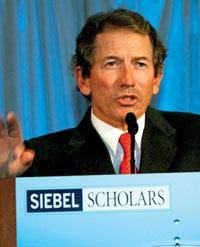You are here

Gifts from James Clark, Alice Woo, and the Siebel Foundation, have played a key role in the rise of Stanford’s bioengineering department.
Bioengineering Charts New Directions
Winter 2010
One of today's biggest medical challenges is the rise of antibiotic-resistant bacteria. But soon, Stanford-created technology could give doctors a new weapon against these deadly organisms. Associate Professor Annelise Barron is building artificial molecules that augment the body's natural defense system. Barron's findings hold the promise of a low-cost, durable antibiotic that could counter stubborn pathogens.
Her work is one of many groundbreaking projects pursued in Stanford's Department of Bioengineering, the first at the university to bridge two schools—the School of Medicine and the School of Engineering. Thanks to early support from visionary donors, the department has become a leading player in the field in just a few short years.
 Faculty: The Vital Foundation
Faculty: The Vital Foundation
"Bioengineering is the fusion of discovery and problem solving," explains department chair Russ Altman, PhD '89, MD '90, "and a blend of biological sciences, medicine, and engineering." The combination yields important insights and inventions, such as uncovering cancer stem cells or creating a silicon replacement for the human retina.
After its 2002 launch, the fledgling department got a jump start from Silicon Valley entrepreneur and former Stanford professor James Clark, who provided the funding to enable junior faculty like Barron to establish specialized labs. Clark's gift was central to attracting a lineup of world-class researchers who now total 19, including Scott Delp and James Swartz, inaugural holders of the Clark Professorships in Bioengineering. Several have won prestigious National Institutes of Health awards for their pioneering research.
Research: The Path to Invention
The department balances "basic research"—the fundamentals behind biomedical phenomena—with "translational" work, moving breakthroughs from the lab into patient care.
In one translational project, Professors Brian Hargreaves and Garry Gold of Stanford's radiology department have discovered how to use magnetic resonance imaging (MRI) to capture an accurate image around metal implants, which otherwise would distort the picture. They have teamed up with Delp in bioengineering and Stuart Goodman in orthopaedics to evaluate joint replacements, especially in helping patients avoid unnecessary surgery.
This work was one of many investigations supported by the Coulter Foundation Translational Research Grant Program, of which Stanford is one of nine national partners. Founded by engineer and inventor Wallace H. Coulter, the foundation, based in Miami, created this grant program in 2006 to bring together clinical researchers and biomedical engineers. It offers support that is much needed: "Funding for projects on the verge of commercial viability is often difficult to find," says Altman.
 Fellowships: "Absolutely Critical"
Fellowships: "Absolutely Critical"
Another vital ingredient in building the department is graduate student funding. "Fellowships are absolutely critical," says Altman. "Graduate students are the lifeblood of groundbreaking research."
Alice Woo helped bioengineering recruit top graduate scholars by creating the Vincent Woo Memorial Fellowship in honor of her father. "With a fellowship, you encourage the best people to come to Stanford," says Woo, who has also directly supported the research of Bioengineering Associate Professor Karl Deisseroth, seeking to use photosensitive brain implants to treat mental illness.
Support has also come from the Siebel Foundation, established in 1996 by Thomas and Stacey Siebel. Five of the most talented individuals are selected from among the department's top-ranked graduate students to receive a Siebel Scholar award. "We want to empower a worldwide community of leaders who are prepared to take on pressing global problems," says Siebel. "Stanford bioengineering students are among the best and the brightest."
 Building: Making Way for the Future
Building: Making Way for the Future
To accommodate the department’s stellar growth, a new collaborative facility housing bioengineering alongside the Department of Chemical Engineering will soon rise on the west side of campus, providing an "intellectual center," says Altman.
Construction can't begin soon enough: Researchers are running out of space for their equipment, and the department's recently launched undergraduate major is in need of classrooms and labs. "It’s a very exciting field," says fellowship donor Woo. "I believe breakthrough discoveries in bioengineering will truly advance the well-being of mankind."